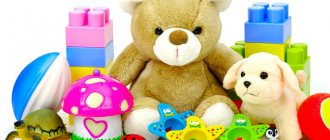Card index of games for the development of sound culture of speech
We invite you to familiarize yourself with a selection of games that are aimed at developing the sound culture of speech.
For the middle group of kindergarten
Game 1 “Sound Chain”
To play the game you will need a card with images of different objects. For example, in the first image the children see a tomato. They determine which letter the word begins with and then which letter it ends with. After this, the kids look for a picture that begins with the last letter of the previous word - in our case it is “P”. And so on for at least 10 words in a chain.
At the same time, children must name words and highlight the extreme sounds in them with their voice.
Game 2 “Look for a place for sound”
For this game, adults will need cards with various objects and cards with sound patterns (they always have one cell with the desired sound painted over).
You need to choose pictures in which the same sound occurs, but in different places (for example, a bus, a dress and a book).
Kids must match the pictures with the proposed diagrams.
Game 3 “Who lives in the house?”
You need to prepare flat houses with a letter in the attic and cards with images of objects. In the attic of each house there is a letter written - for example, s, z, k or p.
Place pictures on the table with words that begin with the suggested sounds. For the letter “k” – cat, goat and chicken, for the letter “c” – elephant, owl, dog, for the letter “z” – hare, zebra.
The children's task is to “resettle” the animals in the appropriate houses.
Game 4 “Buyer - Seller”
The game exercise is aimed at improving the differentiation of the sounds r-l and s-sh. The adult tells the children that today he will be a salesman in a big store, and the kids will be buyers. In this case, instead of money, students receive cards with sounds. Then the adult says that for these sounds in the store you can buy all the goods whose names contain one or another sound.
Products must be selected in such a way that they contain the sounds r, l, s and sh.
Game 5 “Match a Pair”
This game develops children's ability to distinguish words that differ only in sound.
Cards with the following images are laid out in one column: cat, braid, bear, cancer, roof, house, wasps. And in the second column you need to put the following pictures: whale, goat, mouse, poppy, rat, smoke, mustache.
The children's task is simple - to connect the words in pairs.
For the younger group of kindergarten
Game 1 “Blow the fluff”
The following games are aimed at developing phonemic awareness, speech attention and breathing, as well as reinforcing the correct pronunciation of sounds and whole words.
Modern methods and games for teaching speech for non-speaking children
Children stand in a circle, each of them is given a small piece of fluff (can be replaced with a piece of medical cotton wool). Kids are invited to place their palm in front of their face and blow on the fluff, saying “Fuuuu”. There must be at least five such repetitions.
Game 2 “Honey Lovers”
The adult tells the students that today they will be bears. And bears love honey very much. Kids should bring their “paw” to their mouth and imitate how bears lick honey from their paws. In this case, children do not need to touch their hands. Then you need to lick your lips in a circle.
The teacher must show all the movements to the children by example.
Then the teacher asks: “Are our bears full?” Children stroke their bellies and say: “Uuuuu” (several times).
The game is repeated at least 4 times.
Game 3 “Feed the birds”
The teacher says that she will be a mother bird, and the pupils will be her chicks. An adult invites the kids to run in a circle, flap their wings and shout: “Pi-pi-pi-pi.”
Then “mother” tells the children what they will eat now. Children should sit down, raise their heads up and open their mouths wide. Stay in this position for a few seconds.
Game 4 “Clock”
The teacher asks how the clock runs, the children answer: “Tick-tock.” Then the adult says: “How does the clock strike?” The children responded: “Bim-bom.” The teacher invites the children to ring the clock loudly, then show them how they walk - also loudly. Repeat sound combinations 5 times.
Then the children need to be shown how a small clock walks and strikes - while the children’s voice needs to be lowered. Repeat also 5-6 times.
Card index of games for older children
All the following game exercises are performed to reinforce correct pronunciation and differentiation of sounds.
Game 1 “Tell me like I do”
To play the game you will need a ball.
Children stand in a circle, and the teacher throws the ball and says any word with an emphasis on hard or soft sounds. The child repeats the word with the same accent. And so each child says in a circle.
If the baby fails to pronounce the word the first time, the adult repeats it several times.
Game 2 “Name the words”
The teacher asks the children to name all the words that contain the sound r or r. For each correct answer, the child receives a chip. The one who collects the most chips wins.
The same exercise is carried out with the sounds l or l.
Game 2 “Read the tongue twisters”
The teacher offers to pronounce the phrases correctly. They are pronounced in two breaths. The first two lines are for one exhalation, two more lines are for the second exhalation.
Suggested tongue twister: “Rain, rain, Don’t rain!” Let the gray-haired Grandfather reach home.”
First they say it loudly in chorus, and then each child speaks separately 2-3 times.
Game 3 “Make up the ending”
The teacher reads the lines of poems, and the children come up with the endings of the lines.
Poem examples:
“It’s not an alarm clock, but it will wake you up, it will sing, people will wake up.
There is a comb on the head, this is Petya. (cockerel).
Open lesson on speech development in the second junior group
I washed my face early this morning. (faucet).
The sun is shining very brightly, Hippopotamus has become. (hot).
Suddenly the sky became cloudy and lightning came out of the clouds. (flashed).”
Game 5 “Search for the same sound”
The teacher names pairs of words that have the same sounds. In this case, you first need to pronounce the syllables drawn out, and then clearly, stopping after each syllable.
For example, take the words “car” and “raspberry”. The adult says: “Maaaaashinaaaa,” then – “Maaaaaalinaaaa.” After this, he pronounces with a clear pause: “Ma-shi-na” and “Ma-li-na.”
Children must clap their hands for each syllable and count how many there are in each word. And then name those syllables that are repeated in both the first and second words.




